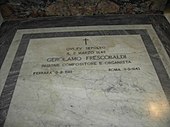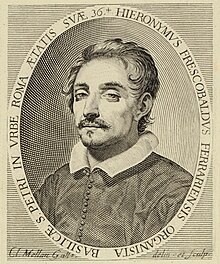Girolamo Frescobaldi
Girolamo Alessandro Frescobaldi (born September 9, 1583 in Ferrara , † March 1, 1643 in Rome ) was an Italian composer , organist and harpsichordist of the early Baroque .
Life
Frescobaldi grew up in the highly educated and musical atmosphere of Ferrara and the local court of the Estonians . He was tutored by Luzzasco Luzzaschi and at the age of 17 astonished his fellow citizens with his excellent organ playing. In 1597 he succeeded Ercole Pasquini at the Accademia della morte (Ferrara), and in 1607 in Rome organist at the Church of Santa Maria in Trastevere . In the wake of his patron, Cardinal Guido Bentivoglio , he traveled to Brussels in the Spanish Netherlands , where he stayed for almost a year, and very likely met northern European musicians such as Peter Philips and Pieter Cornet . After his return to Rome in 1608, thanks to Bentivoglio's intercession, he got a job as organist of St. Peter's Church (more precisely the Capella Giulia ), again as Ercole Pasquini's successor. Frescobaldi also served as a musician for Roman personalities such as Cardinal Pietro Aldobrandini . In 1615 he was organist in Mantua for a year and from 1628 to 1633 court organist in Florence . In 1634 he again took over the position of organist at St. Peter's Basilica. In Rome he continued to socialize in high circles; some of his works are dedicated to the Barberini family , from which the then Pope came. He also worked for the oratorio Santissimo Crocifisso . Many German organists made a pilgrimage to Rome to learn from him, among other things. a. Johann Jacob Froberger .

Frescobaldi is particularly known for his compositions for keyboard instruments such as the toccatas , which consist of various small sections of different characters and expressions (" affect "). He also wrote ricercari , canzonen , capricci for organ and harpsichord , which were widely admired for their extraordinary compositional skill. There are also various artistic variations on the then modern Italian dance basses such as the Romanesca , the Ruggiero , the Aria La Monicha , Fedele , and the Cento Partite sopra Passacagli ; and also a number of elegantly elaborated dances, such as gagliarden and correnten , as well as “balletti”, which consist of a series of different dances and represent a (preliminary) form of the suite . His Capriccio pastorale in the Aggiunta (additional pieces ) from 1637 to the first book of toccata (1615) is the earliest surviving piece of this kind. In most of the genres mentioned, he had an enormous influence on the keyboard music of his time and the following generations.
Frescobaldi's final resting place is in the Basilica of Santi Apostoli in Rome.
Importance as a composer
Frescobaldi, together with Sweelinck, is considered to be the most influential composer for keyboard instruments of the first half of the 17th century. He is one of the first to write extensive musical works that are not supported by a text. He faced this challenge in more than thirty years as a composer. However, according to today's knowledge, his music (like that of Sweelinck) cannot be classified as completely isolated; rather, his oeuvre is based both stylistically and formally on the works of somewhat older composers such as his Ferrarese compatriot Ercole Pasquini and the Neapolitan school with Giovanni Maria Trabaci and Ascanio Mayone at the head. The knowledge of the late Mannerist toccatas, which were pioneering in the late manner of the time, by Claudio Merulo, who worked in Venice and Parma, may also have flowed into his toccaten art.
Johann Jakob Froberger was the most important and influential of his students ; he studied with him from 1637 to 1641; the (later) abbot Otto Kübler also took lessons from Frescobaldi in 1637. Frescobaldi's music also influenced Michelangelo Rossi , Bernardo Storace , Bernardo Pasquini , Louis Couperin , and especially many German organists of the 17th and early 18th centuries, such as Johann Caspar Kerll , Johann Pachelbel , Dieterich Buxtehude and even Johann Sebastian Bach .
Trivia
- At the end of Toccata IX (of Libro II, 1626), a difficult piece with various changes of meter and sometimes different rhythms in the two hands, Frescobaldi writes: Non senza fatiga si giunge al fin (you cannot reach the end without effort)
- In honor of the composer, a free source text editor for LilyPond files was named Frescobaldi .
Works (selection)

Works for keyboard instruments
- Il primo libro delle fantasie a quattro , Milan , 1608
- Toccate e partite d'intavolatura di cimbalo libro primo, Rome, 1615.
- Recercari, et canzoni franzese fatte sopra diverse oblighi in partitura libro primo, Rome, 1615
- Il primo libro di capricci fatti sopra diversi soggetti et arie in partitura , Rome, 1624
- Il secondo libro di toccate, canzone, versi d'hinni, Magnificat, gagliarde, correnti et altre partite d'intavolatura di harpsichord et organo , Rome, 1627
- Fiori musicali di diverse compositioni, toccate, kyrie, canzoni, capricci, e recercari, in partitura , Venice, 1635
- Canzoni alla francese in partitura , Venice, 1645
Instrumental music
- 3 canzoni, rispettivamente a 4, 5 e 8 voci, nell'antologia di vari autori Canzoni per Sonare con ogni sorte di Stromenti a Quattro, Cinque & Otto, con il suo Basso generale per l'Organo , Venice, 1608
- Canzoni da sonare a una, due, tre et quattro libro primo, Rome, 1628
Italian vocal music
- Il primo libro de madrigali , a 5 voci, Anversa, 1608
- Primo Libro d'Arie Musicali Per Cantarsi Nel Gravicembalo, e Tiorba , a 1-3 voci, Florence , 1630
- Secondo Libro d'Arie Musicali Per Cantarsi Nel Gravicembalo, e Tiorba , a 1-3 voci, Florence, 1630
- Alcune aria a 1 e 2 voci con basso continuo in raccolte dell'epoca
Latin vocal music
- Liber secundus diversarum modulationum , mottetti a 1-4 voci, Rome 1627
- Missa sopra l'aria della monica a 8 voci
- Missa sopra l'aria di Fiorenza a 8 voci
- Alcuni mottetti a 3 e 4 voci in raccolte dell'epoca
- Un mottetto manoscritto
Arrangements (for guitar and lute duo)
- Ruggero Chiesa: Toccata. Edizioni Suvini Zerboni, Milan.
- M. Lonardi: Canzona secunda detta "La Bernardina" per due liuti. Edizioni Suvini Zerbon, Milan.
literature
- Frederick Hammond: Girolamo Frescobaldi. Harvard University Press, Cambridge MA 1983, ISBN 0-674-35438-9 .
- Domenico Morgante: Girolamo Frescobaldi . In: Alberto Basso (Ed.): Dizionario enciclopedico universale della musica e dei musicisti (DEUMM) . Le biography . Vol. III: Fra - Yes . UTET, Turin 1986, ISBN 88-02-04041-9 .
- Oscar Mischiati: Frescobaldi, Girolamo. In: Fiorella Bartoccini (ed.): Dizionario Biografico degli Italiani (DBI). Volume 50: Francesco I Sforza-Gabbi. Istituto della Enciclopedia Italiana, Rome 1998, exact date of birth unknown, baptism on September 13, 1583.
- Gunther Morche: Frescobaldi, Girolamo, Alissandro. In: Ludwig Finscher (Hrsg.): The music in past and present . Second edition, personal section, volume 7 (Franco - Gretry). Bärenreiter / Metzler, Kassel et al. 2002, ISBN 3-7618-1117-9 ( online edition , subscription required for full access)
- Frederick Hammond, Alexander Silbiger: Frescobaldi, Girolamo Alessandro. In: Grove Music Online (English; subscription required).
- Franz Xaver Hieronymus (Ed.): Frescobaldi (1583–1644) . Selected organ movements from his printed works. 1st and 2nd volume in a book (textbook), Breitkopf & Härtel , Leipzig undated
Web links
- Catalog of works at Duke University
- Works by and about Girolamo Frescobaldi in the catalog of the German National Library
- Works by and about Girolamo Frescobaldi in the German Digital Library
- Sheet music and audio files by Girolamo Frescobaldi in the International Music Score Library Project
- Sheet music in the public domain by Girolamo Frescobaldi in the Choral Public Domain Library - ChoralWiki (English)
Remarks
- ↑ which, however, had little or at least no direct influence on him.
- ↑ An early form of the follia .
- ↑ Carl Philipp Emanuel Bach wrote in a letter to Johann Nikolaus Forkel : His father “loved and loved the works of Frescobaldi, the Baden Capellmeister Fischer, Strungk“ besides Frobergern, Kerl u Pachhelbel ”. studirt ”(Bach Documents III, No. 803, pp. 288–290).
| personal data | |
|---|---|
| SURNAME | Frescobaldi, Girolamo |
| ALTERNATIVE NAMES | Frescobaldi, Girolamo Alessandro; Frescobaldi, Geronimo; Frescobaldi, Girolimo; Frescobaldi, Geronimo Alissandro |
| BRIEF DESCRIPTION | Italian organist and composer of the Baroque era |
| DATE OF BIRTH | September 9, 1583 |
| PLACE OF BIRTH | Ferrara |
| DATE OF DEATH | March 1, 1643 |
| Place of death | Rome |
